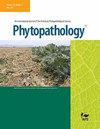Khee Man Kwon, Rick E Masonbrink, Thomas R Maier, Michael N Gardner, Andrew J Severin, Thomas J Baum, Melissa G Mitchum
求助PDF
{"title":"不适应或适应大豆 rhg1-a/Rhg4 介导的抗性的大豆胞囊线虫近交系种群的转录组比较分析。","authors":"Khee Man Kwon, Rick E Masonbrink, Thomas R Maier, Michael N Gardner, Andrew J Severin, Thomas J Baum, Melissa G Mitchum","doi":"10.1094/PHYTO-03-24-0095-R","DOIUrl":null,"url":null,"abstract":"<p><p>Soybean cyst nematode (SCN, <i>Heterodera glycines</i>) is most effectively managed through planting resistant soybean cultivars, but the repeated use of the same resistance sources has led to a widespread emergence of virulent SCN populations that can overcome soybean resistance. Resistance to SCN HG type 0 (Race 3) in soybean cultivar Forrest is mediated by an epistatic interaction between the soybean resistance genes <i>rhg1-a</i> and <i>Rhg4</i>. We previously developed two SCN inbred populations by mass-selecting SCN HG type 0 (Race 3) on susceptible and resistant recombinant inbred lines, derived from a cross between Forrest and the SCN-susceptible cultivar Essex, which differ for <i>Rhg4</i>. To identify SCN genes potentially involved in overcoming <i>rhg1-a</i>/<i>Rhg4</i>-mediated resistance, we conducted RNA sequencing on early parasitic juveniles of these two SCN inbred populations infecting their respective hosts, only to discover a handful of differentially expressed genes (DEGs). However, in a comparison with early parasitic juveniles of an avirulent SCN inbred population infecting a resistant host, we discovered 59 and 171 DEGs uniquely up- or downregulated in virulent parasitic juveniles adapted on the resistant host. Interestingly, the proteins coded by these 59 DEGs included vitamin B-associated proteins (reduced folate carrier, biotin synthase, and thiamine transporter) and nematode effectors known to play roles in plant defense suppression, suggesting that virulent SCN may exert a heightened transcriptional response to cope with enhanced plant defenses and an altered nutritional status of a resistant soybean host. [Formula: see text] Copyright © 2024 The Author(s). This is an open access article distributed under the CC BY-NC-ND 4.0 International license.</p>","PeriodicalId":20410,"journal":{"name":"Phytopathology","volume":" ","pages":"2341-2350"},"PeriodicalIF":3.1000,"publicationDate":"2024-10-01","publicationTypes":"Journal Article","fieldsOfStudy":null,"isOpenAccess":false,"openAccessPdf":"","citationCount":"0","resultStr":"{\"title\":\"Comparative Transcriptomic Analysis of Soybean Cyst Nematode Inbred Populations Non-adapted or Adapted on Soybean <i>rhg1-a</i>/<i>Rhg4</i>-Mediated Resistance.\",\"authors\":\"Khee Man Kwon, Rick E Masonbrink, Thomas R Maier, Michael N Gardner, Andrew J Severin, Thomas J Baum, Melissa G Mitchum\",\"doi\":\"10.1094/PHYTO-03-24-0095-R\",\"DOIUrl\":null,\"url\":null,\"abstract\":\"<p><p>Soybean cyst nematode (SCN, <i>Heterodera glycines</i>) is most effectively managed through planting resistant soybean cultivars, but the repeated use of the same resistance sources has led to a widespread emergence of virulent SCN populations that can overcome soybean resistance. Resistance to SCN HG type 0 (Race 3) in soybean cultivar Forrest is mediated by an epistatic interaction between the soybean resistance genes <i>rhg1-a</i> and <i>Rhg4</i>. We previously developed two SCN inbred populations by mass-selecting SCN HG type 0 (Race 3) on susceptible and resistant recombinant inbred lines, derived from a cross between Forrest and the SCN-susceptible cultivar Essex, which differ for <i>Rhg4</i>. To identify SCN genes potentially involved in overcoming <i>rhg1-a</i>/<i>Rhg4</i>-mediated resistance, we conducted RNA sequencing on early parasitic juveniles of these two SCN inbred populations infecting their respective hosts, only to discover a handful of differentially expressed genes (DEGs). However, in a comparison with early parasitic juveniles of an avirulent SCN inbred population infecting a resistant host, we discovered 59 and 171 DEGs uniquely up- or downregulated in virulent parasitic juveniles adapted on the resistant host. Interestingly, the proteins coded by these 59 DEGs included vitamin B-associated proteins (reduced folate carrier, biotin synthase, and thiamine transporter) and nematode effectors known to play roles in plant defense suppression, suggesting that virulent SCN may exert a heightened transcriptional response to cope with enhanced plant defenses and an altered nutritional status of a resistant soybean host. [Formula: see text] Copyright © 2024 The Author(s). This is an open access article distributed under the CC BY-NC-ND 4.0 International license.</p>\",\"PeriodicalId\":20410,\"journal\":{\"name\":\"Phytopathology\",\"volume\":\" \",\"pages\":\"2341-2350\"},\"PeriodicalIF\":3.1000,\"publicationDate\":\"2024-10-01\",\"publicationTypes\":\"Journal Article\",\"fieldsOfStudy\":null,\"isOpenAccess\":false,\"openAccessPdf\":\"\",\"citationCount\":\"0\",\"resultStr\":null,\"platform\":\"Semanticscholar\",\"paperid\":null,\"PeriodicalName\":\"Phytopathology\",\"FirstCategoryId\":\"97\",\"ListUrlMain\":\"https://doi.org/10.1094/PHYTO-03-24-0095-R\",\"RegionNum\":2,\"RegionCategory\":\"农林科学\",\"ArticlePicture\":[],\"TitleCN\":null,\"AbstractTextCN\":null,\"PMCID\":null,\"EPubDate\":\"2024/10/4 0:00:00\",\"PubModel\":\"Epub\",\"JCR\":\"Q2\",\"JCRName\":\"PLANT SCIENCES\",\"Score\":null,\"Total\":0}","platform":"Semanticscholar","paperid":null,"PeriodicalName":"Phytopathology","FirstCategoryId":"97","ListUrlMain":"https://doi.org/10.1094/PHYTO-03-24-0095-R","RegionNum":2,"RegionCategory":"农林科学","ArticlePicture":[],"TitleCN":null,"AbstractTextCN":null,"PMCID":null,"EPubDate":"2024/10/4 0:00:00","PubModel":"Epub","JCR":"Q2","JCRName":"PLANT SCIENCES","Score":null,"Total":0}
引用次数: 0
引用
批量引用

 求助内容:
求助内容: 应助结果提醒方式:
应助结果提醒方式:


